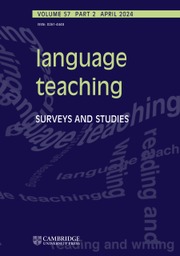Crossref Citations
This article has been cited by the following publications. This list is generated based on data provided by
Crossref.
Calzada, Asier
and
García Mayo, María del Pilar
2020.
Child EFL learners’ attitudes towards a collaborative writing task.
Language Teaching for Young Learners,
Vol. 2,
Issue. 1,
p.
52.
Li, Mimi
2020.
Languaging in Language Learning and Teaching.
Vol. 55,
Issue. ,
p.
149.
Kessler, Matt
2020.
Promoting text co‐ownership and peer interactions in collaborative writing.
TESOL Journal,
Vol. 11,
Issue. 2,
Elabdali, Rima
and
Arnold, Nike
2020.
Group Dynamics across Interaction Modes in L2 Collaborative Wiki Writing.
Computers and Composition,
Vol. 58,
Issue. ,
p.
102607.
Richards, Laura
2020.
Innovative language teaching and learning at university: treasuring languages.
p.
33.
UZUN, Kutay
and
KÖKSAL, Handan
2020.
Direct vs Indirect Written Corrective Feedback: An Action Research.
Trakya Eğitim Dergisi,
Vol. 10,
Issue. 1,
p.
169.
Kim, YouJin
Choi, Bumyong
Kang, Sanghee
Kim, Binna
and
Yun, Hyunae
2020.
Comparing the effects of direct and indirect synchronous written corrective feedback: Learning outcomes and students' perceptions.
Foreign Language Annals,
Vol. 53,
Issue. 1,
p.
176.
Zhang, Meixiu
and
Plonsky, Luke
2020.
Collaborative writing in face-to-face settings: A substantive and methodological review.
Journal of Second Language Writing,
Vol. 49,
Issue. ,
p.
100753.
Luquin, María
and
García Mayo, María del Pilar
2020.
Collaborative writing and feedback.
Language Teaching for Young Learners,
Vol. 2,
Issue. 1,
p.
73.
García Mayo, María del Pilar
2021.
Editorial.
Language Teaching for Young Learners,
Vol. 3,
Issue. 2,
p.
181.
Saeed, Murad Abdu
Alharbi, Mohammed Abdullah
and
Yassin, Amr Abdullatif
2021.
Sustaining Synchronous Interaction Effectiveness in Distance Writing Courses: A Mixed Method Study in a KSA University.
Sustainability,
Vol. 13,
Issue. 24,
p.
13675.
Pham, Vu Phi Ho
2021.
The Effects of Collaborative Writing on Students’ Writing Fluency: An Efficient Framework for Collaborative Writing.
Sage Open,
Vol. 11,
Issue. 1,
Jin, Lining
Liu, Xiaobin
Gong, WeiQin
and
Chen, Guangwei
2021.
Emerging Technologies for Education.
Vol. 13089,
Issue. ,
p.
142.
Calzada, Asier
and
García Mayo, María del Pilar
2021.
Effects of proficiency and collaborative work on child EFL individual dictogloss writing.
Language Teaching for Young Learners,
Vol. 3,
Issue. 2,
p.
246.
Roca de Larios, Julio
García Hernández, Francisco Javier
and
Coyle, Yvette
2021.
A theoretically-grounded classification of EFL children’s formulation strategies in collaborative
writing.
Language Teaching for Young Learners,
Vol. 3,
Issue. 2,
p.
300.
Elabdali, Rima
2021.
Are two heads really better than one? A meta-analysis of the L2 learning benefits of collaborative writing.
Journal of Second Language Writing,
Vol. 52,
Issue. ,
p.
100788.
Zheng, Yao
Yu, Shulin
and
Lee, Icy
2021.
Implementing Collaborative Writing in Chinese EFL Classrooms: Voices From Tertiary Teachers.
Frontiers in Psychology,
Vol. 12,
Issue. ,
Akoto, Miriam
2021.
Collaborative Multimodal Writing via Google Docs: Perceptions of French FL Learners.
Languages,
Vol. 6,
Issue. 3,
p.
140.
Trim, Michelle
Obara, Justin
and
Mei, Siobhan
2021.
Opportunities for innovation gained by connecting a customized process document to the collaborative development of an asynchronous online writing course.
p.
338.
Zhang, Meixiu
Gibbons, John
and
Li, Mimi
2021.
Computer-mediated collaborative writing in L2 classrooms: A systematic review.
Journal of Second Language Writing,
Vol. 54,
Issue. ,
p.
100854.

